#western monarch butterflies
Explore tagged Tumblr posts
Text
Excerpt from this story from The Revelator:
Every fall dozens of monarch butterfly enthusiasts deploy to groves on the California coast to tally the orange-and-black insects who spend the winter clustered on tree limbs. In 2024 there were more volunteers than ever, but dreadfully few of the colorful butterflies to count.
On Dec. 9 a monarch lover named Saunie Holloway posted numbers from her annual pilgrimage to the Pismo Beach grove on the Western Monarch Advocates Facebook page. This grove is usually a favorite: More than 16,000 butterflies had adorned the eucalyptus trees there in 2023.
In 2024 volunteers counted fewer than 200.
“I just stood in the grove and wept,” Holloway wrote.
On Jan. 30 the Xerces Society for Invertebrate Conservation announced the official peak season numbers for Western monarchs: just 9,119 butterflies in 257 overwintering sites. It’s the lowest count since 2020, and the second-lowest since 1997.
The distressingly low numbers coincided with the U.S. Fish and Wildlife Service’s Dec. 12 proposal to list the monarch as threatened under the federal Endangered Species Act.
The population west of the Rocky Mountains is in especially dire straits. Western monarchs, already a fraction of the size of the eastern population, has shrunk to just 1% of its historic abundance. If nothing changes, the Service estimates, western monarchs face a 99% chance of going extinct in the next 50 years.
As numbers have plummeted, advocates have doubled down to save their western butterflies. This loose network of conservationists, educators, and citizen scientists — as dispersed as the butterflies themselves — have used technology and social media to connect and effectively share their messages. Both awareness and acres of pollinator habitat planted have expanded.
These efforts have been critical, says Isis Howard, an endangered species conservation biologist at Xerces Society.
But to help monarchs recover, she says, “We need to work at a larger scale and address widespread issues … beyond what voluntary efforts have been able to achieve.”
Most western monarchs overwinter at some 400 sites on the California and Baja coasts. They leave their coastal groves in late winter and early spring, dispersing into California, Oregon, Washington, Idaho, and beyond, breeding along the way. It takes several generations to make these yearly journeys; the butterflies who return to coastal groves are not the same individuals as the ones who left the year before.
The reasons for western monarchs’ decline are complex. Pesticides, habitat loss, and climate change are the most oft-cited factors. With numbers so low, other factors — predators, disease, and extreme weather events, for example — loom larger.
7 notes
·
View notes
Text
Happy Western Monarch Day to those who celebrate 🦋

yes that's a real day and yes it's today :]
#art#bugs#pixel art#artists on tumblr#insects#tumblr art#pixel graphics#art comms open#game dev#monarch#lepidoptera#butterfly#Western monarch day#bug blog#bugblr#bug game
139 notes
·
View notes
Text
western monarch day here's a shitty picture i made in like 7 minutes

thank you school for free Photoshop 🛐
12 notes
·
View notes
Text






























Learn About Butterflies Day
In keeping with the spirit of Learn About Butterflies Day, celebrate by learning a little more about the wide range of butterflies. With over 20,000 types of butterflies worldwide today is the perfect day to learn about butterflies. Their wing spans can range from ½ inch to 11 inches. Did you know that in their adult stage butterflies can live from a week up to a year, depending on the species? Many butterflies migrate over long distances the most famous migrations are those of the Monarch butterfly from Mexico to the northern USA and southern Canada, a distance of about 2500 to 3000 miles. That’s a lot of air miles!
If you need some inspiration about how to celebrate, here are five ideas for you to try:
1. Start a butterfly garden.
One of the best ways to attract butterflies to your yard is to plant nectar-producing flowers that have red, yellow, orange, pink, or purple blossoms. Plant them in a sunny spot in a group so they grow in clusters.
2. Make a butterfly snack.
Fresh fruit is the perfect springtime snack, so use your imagination to whip up a fruity butterfly treat. You can also put a bit of fruit out in your garden for the butterflies to enjoy.
3. Learn something you didn’t know about butterflies.
Did you know that a butterfly can’t fly if its body temperature falls below 86°F? Or that they drink the tears of turtles? And they use their feet to taste?
4. Get crafty.
Grab some card, pipe cleaners and clothes peg and some pom-poms and here’s how you create your own butterfly:
Decorate some card with markers and then spray it with water to create its wings.
Once it dries, wrap a pipe cleaner around the middle of the card.
Glue pom-poms onto the clothespin and clip the clothespin to the cards.
Bend the pipe cleaner to make the antennae.
5. Visit your local zoo.
If in doubt learn from the experts. Heading to your local zoo and talking to the keepers that look after these amazing creatures from caterpillar to larvae and then to butterfly. They will be able to show you just how amazing these creatures are.
Source
Observed annually, March 14th is National Learn About Butterflies Day. Spring and summer are just right around the corner, so it is a good time to take a few minutes and learn something new about butterflies and appreciate their beauty.
Butterflies need our help to survive as they rely on flowers and other natural sources for survival. We can help them by planting more flowers.
There are more than 20,000 types of butterflies worldwide
Their wing spans can range from ½ inch to 11 inches.
Butterflies in their adult stage can live from a week to nearly a year, depending on the species.
Many butterflies migrate over long distances. Particularly famous migrations are those of the Monarch butterfly from Mexico to the northern USA and southern Canada, a distance of about 2500 to 3000 miles.
Source
#Green comma#Compton tortoiseshell#Milbert's tortoiseshell#Painted lady#travel#original photography#vacation#tourist attraction#landscape#cityscape#insect#wildlife#animal#flower#fauna#flora#European peacock#Silver-washed fritillary#Sweden#Western Monarch#Eastern tiger swallowtail#red-spotted purple butterfly#Black Swallowtail#Giant Swallowtail#Common wood-nymph#butterfly bush#Learn About Butterflies Day#NationalLearnAboutButterfliesDay#14 March#USA
3 notes
·
View notes
Text


Hello my beautiful friends! Monarch caterpillars on the milkweed next to my apartment building 💚☺️
#monarch#butterflies#caterpillars#milkweed#native flowers#native species#native plants#pollinators#Ny#western ny
2 notes
·
View notes
Text






7/5/24
life in the milkweed
#red milkweed beetle#coleoptera#western honey bee#hymenoptera#asian lady beetle#wasp#monarch butterfly caterpillar#lepidoptera
0 notes
Note
I neeedd you at some point write uni au Toji proposing to reader and megumi helping out in the background somehow
NOOOO BC IMAGINE TOJI TRYING TO GET THE WORDS OUT, AND MEGUMI IS PLAYING WITH THE BUTTERFLY THATS FLYING AROUND SJDJDINEKEENE IM UNWELL- also i had to go with a western approach for proposal im sORRY-
Like, Toji has practiced this speech before. A lot. He’s trying to keep his declaration of love for you concise but meaningful, simple but sweet, but what he does know, is he wants Megumi to be the one holding the box.
Because you haven’t just accepted toji for all he is. You’ve also taken megumi as your whole world, and he never can say just how grateful he is for that.
So, he works it all out. He’s going to propose in the courtyard, and his buddies are going to help him decorate it up slightly, so your friends can take pictures of the event. He’ll have Megumi bring out the small box with the ring in it, give a short but sweet speech about how much he loves and needs you in his life, only to pop the question there.
Your friends spend the week prior to pamper you, and toji makes it a point to compliment you on your updates- the small kiss you press to his cheek in appreciation is enough to make it worth it, but he just hopes you don’t catch on to anything until the end of the week.
“Geez,” you giggle. “The girls are getting me buttered up for something,” you say one night. “Every time I ask about it, they tell me it’s self care week, but we’ve never done this thorough before.”
“You have been extra busy lately, maybe they’re just trying to take care of you,” he defends.
You open your mouth to say something, only to completely change your demeanor as megumi appears in the doorway, stuffed cow clutched to his chest and a soft “daaaaad?” falling from his lips. He’s grateful for the topic change, not wanting you to ruin your own proposal with your damn questions.
The day of the proposal, you’re kept far away from campus, last minute touch ups and errands while Toji’s friends help him set up the perfect decorations and ambiance for pictures that your friends are scheduled to take.
Everything goes to plan. Everything is perfect.
And when you finally come up to him, a knowing smile and tears in your eyes, he wastes no time in kissing your cheek, then between your brows, your nose, and-
There’s a soft giggle behind him. One from megumi. Your eyes leave Toji’s to turn to the small boy, laughing as you watch. When toji also turns to see his son, there’s a large monarch butterfly that’s fluttering around, delicate wings brushing against the small boys cheek, only to then land on it moments later. Instinctively, Megumi goes to wipe his cheek, and when the butterfly tries to land once more, tiny hands bat at it away, causing everyone watching to coo in adoration.
“Kid’s stealing my thunder,” toji chuckles, and you laugh as a tears finally fall from your eye, and his big hand comes up to swipe the drop from your cheek. “Megs, c’mere.”
“Pretty butterfly,” the small boy hums, but he does toddle over to his dad with the small box in his hand, and you let the floodgates open. You’re trying to wipe the tears from your eyes, freeing your sight from the blur, and you watch as Toji gets down on one knee, flips open the box and reveals the ring. Toji sighs, “I couldn’t afford a bigger one, but someday, I promise you, I’ll-“
“Don’t,” you say softly. “It’s perfect. It’s the most beautiful ring I’ve ever seen, Toji.”
“I helped,” megumi says shyly, rocking back and forth on his feet. You laugh around your tears and gently grab his cheeks, placing a big kiss to the swell. He giggles and smiles at the affection, wrapping his arms around your neck. You scoop him up, but leave your left hand open for his father to slip the ring on, a final seal as you truly become a family.
#IM GONNA COMBUST I LOVE BABY MEGUMI 🥺🥺#toji fushiguro#toji fushiguro fluff#toji fushiguro x reader#toji fushiguro x reader fluff#toji fushiguro x f!reader#toji fushiguro imagine#toji fushiguro jjk#megumi fushiguro#megumi fushiguro fluff#megumi fushiguro imagine#megumi fushiguro jjk#jjk#jjk fluff#jjk x reader#jjk x reader fluff#jjk x f!reader#jjk x female reader#jjk imagine#jjk x you#jjk x yn#jjk x y/n#baby!au#baby!jjk#baby!megumi#baby!megumi fushiguro
457 notes
·
View notes
Text
While western monarch butterfly (Danaus plexippus) populations are crucially low, it's good to see an uptick in eastern populations. I remember as a child in Missouri in the 1980s that monarchs, along with multiple species of swallowtails, were common visitors to our garden.
In the decades since, though, they have become increasingly scarce. Many patches of milkweed in my old neighborhood have been turned into houses and lawns, depriving monarch caterpillars of their only food. And the story is the same across North America. Not only are native milkweeds less common due to development, but pesticides also take their toll on these magnificent insects.
Thankfully awareness is growing, and more people are planting milkweed and abstaining from using pesticides and other harmful chemicals. But the crucial piece that is still missing is the protection of the monarchs' wintering grounds in the southern United States and Mexico. As logging threatens these dwindling forests, the monarchs have fewer places to hibernate over the coldest months of the year, meaning fewer will survive to produce the next year's first batch of eggs.
Conservation groups like Monarch Watch are working with government agencies and private landowners to protect the monarchs' winter homes, which benefits not only the butterflies but other wildlife, too. And outreach to people across the continent means more patches of native milkweed are popping up in yard, gardens, and open lots. No one can single-handedly save the monarch, but together we may just be able to pull it off--and this year's eastern population numbers are promising.
#butterflies#monarch butterflies#insects#arthropods#invertebrates#wildlife#animals#nature#endangered species#extinction#forests#deforestation#conservation#environment#ecology#biodiversity#hopepunk
157 notes
·
View notes
Text
The trolls as insects (i might draw them later)


Aradia Megido - Maroon Ghost Moth (Elhamma australasiae)
Moths have been repeatedly portrayed as a sign of death. Also, their fluffiness matches the one of Aradia's hair XD. When I read this one's name it was inevitable (ghost???, maroon??, literally her oh my gooood).


Tavros Nitram - Question Mark Butterfly (Polygonia interrogationis)
Mostly based off of the Summoner and Rufioh having wings, I didn't want to make it a monarch butterfly because Tavros is in no way royalty.


Sollux Captor - Western Honey Bee (Apis mellifera)
Pretty self explanatory, Sollux always had a connection (and obsession) with bees. They also sting, which is kind of a metaphor for the psionics.


Karkat Vantas - Seven Spot Ladybird (Coccinella septempunctata)
Ladybirds are always seen as special, even though this instance is not a mutation per se, it's special and red. Also, ladybirds are commonplace pests (which is kind of what Karkat is to HIC).


Nepeta Leijon - Pale Green Assassin Bug (Zelus luridus)
I looked up some good bug hunters and I got assassin bugs, nepeta is the mightiest of huntresses, so it fits.


Kanaya Maryam - Green Headed Ant (Rhytidoponera metallica)
I was doubting wether to make Kanaya an ant or a silk moth, but ultimately, moths are a better representation of Aradia, and ants mimic jade-blood's function in troll society better. A part from being green, this species of ant apparently has a nice bite, which is representative of Kanaya's fierceness.


Terezi Pyrope - Ebony Jewelwing (Calopteryx maculata)
I am aware that the dragonfly pictured is male, just ignore that lol, headcanon the trolls as hermaphroditic (i will post about their biological cycle hehe). Dragonflies are said to be insect's best predators, Terezi is also a vicious and precise hunter, if not of other trolls literally, of outcomes and possibilities (she is intelligent, and a Seer of Mind).


Vriska Serket - Peacock Tarantula (Poecilotheria metallica)
Also pretty self explanatory, it's a blue spider, therefore Vriska Serket. Spiders in general are already a good representation of how she is percieved (with fear lol). Yea, simple explanation.


Equius Zahhak - "Pure Blue" Giant Flower Beetle (Mecynorhina torquata)
The strongest of bugs are beetles (among some types of ants, who are better described as proportionally strongest). This particular one is also pretty big and strong, and coincidentally presents this type of coloration.


Gamzee Makara - Purple-Winged Grasshopper (Titanacris albipes)
Originally was going to be a praying mantis, but the orchid mantis was just too perfect for Feferi. Locusts also have ties to religion and mythology, which was my main focus for finding Gamzee's insect (they have been, fittingly, a symbol of destruction for eons).


Eridan Ampora - Canopy Mosquito (Sabethes cyaneus)
Tbh, I based most of this decision off of the fact that Eridan is annoying (I don't hate him, it's just his personality, unfortunately). Also, mosquitos breed in water (at least that's what my parents always told me) which matches the aquatic theme.


Feferi Peixes - Orchid Mantis (Hymenopus coronatus)
Feferi is the troll I had the most trouble with. Originally I tried keeping up with the aquatic theme and had found Ranatra linearis, a stickbug that looks like a mantis and hunts little fish. I discarded the option because even though it was aquatic, the connections with Feferi kind of ended there.
I then tried to search for a bug that had "empress" in the name, and had chosen Megapomponia imperatoria, a giant as fuck cicada. It didn't convince me either though.
I chose the orchid mantis because, mantises are cutthroat, good hunters and pink as fuck. If that's not a description of the tyrian blood caste I don't know what is.
I wanted to make one of these drawing comparisons to different species of ants. There exist some cool af ants out there, I might do it.
#aradia megido#tavros nitram#sollux captor#karkat vantas#nepeta leijon#kanaya maryam#terezi pyrope#vriska serket#equius zahhak#gamzee makara#eridan ampora#feferi peixes#insects#homestuck
111 notes
·
View notes
Text

Yesterday, I experienced one of those poignant moments as a parent that I never expected. My daughter spotted a monarch butterfly in our garden, a truly breathtaking sight. Her eyes sparkled with excitement, but it was bittersweet. I had to explain how rare and precious this encounter was, given that it might be the last time we see one of these splendid creatures.
The monarch butterfly population is facing a severe crisis. As of 2024, the western monarch population has plummeted by an astonishing 99.9% since the 1980s, with a mere 1,914 butterflies recorded in the annual Western Monarch Thanksgiving Count. The eastern monarchs are also struggling, with a 22% decline in their overwintering numbers from just the previous year. Several factors contribute to this decline: climate change, habitat destruction, and the extensive use of pesticides that eliminate milkweed, the only host plant for monarch larvae. These butterflies, once a common delight, are now on the brink of extinction.
Confronting this harsh reality is devastating, especially when trying to instill a sense of wonder about nature in your children. How do you explain that something as enchanting and vital as a butterfly might vanish forever?
However, this sadness can also be a catalyst for change. We can make choices that help: planting milkweed, avoiding pesticides, and supporting conservation efforts. By teaching our children the significance of environmental protection, we might help ensure that monarchs will visit our gardens once more.
It’s not too late to act, but soon it might be. Let's work together to ensure that future generations can experience the natural world in all its vibrant glory, including the sight of monarchs fluttering freely in our gardens.
45 notes
·
View notes
Text
Introducing the brush-footed butterflies
With 30 species I think I am happy with the diversity represented here and will move on to the next family soon. Which of these is your favorite?



Species pictured (in order of appearance): monarch, queen, gulf fritallary, variegated fritallary, red-spotted purple, zebra longwing, painted lady, American lady, gray buckeye, California patch, bordered patch, Arizona sister, Empress Leila, hackberry emperor, American snout, Polyura dehanii, Texas crescent, tiny checkerspot, mylitta crescent, variable checkerspot, elf, red admiral, mourning cloak, Milbert's tortoiseshell, red-bordered satyr, western red satyr, Anna's 88, malachite, common morpho, and my personal favorite, the blushing phantom
#bugs#art#pixel art#artists on tumblr#tumblr art#insects#pixel graphics#game dev#indie dev#art comms open#butterfly#butterflies#bugtober#bugblr#artist comms#comms open#art commisions#comms#digital art#artwork#pixel illustration
2K notes
·
View notes
Text
Excerpt from this LA Times story:
The Western population of the monarch butterfly has declined to a near-record low with fewer than 10,000 found living in California this winter, a foreboding sign for the future of the beloved black-and-orange insect.
An annual count recorded 9,119 butterflies this winter, according to results released by the Xerces Society for Invertebrate Conservation. This is the second-lowest population recorded since tracking began in 1997. An all-time low of fewer than 2,000 monarchs was recorded in 2020.
The society said these numbers underscored the importance of the U.S. Fish and Wildlife Service’s new proposal to list the butterfly as a federally endangered species.
The butterfly’s Western population has plummeted more than 95% since the 1980s, when up to 4 million butterflies were estimated to spend winter in California, according to the California Department of Fish and Wildlife. Without urgent conservation efforts, the U.S. Fish and Wildlife Service estimates that the Western population faces a 99% chance of extinction by 2080.
Habitat destruction, pesticides and extreme weather fluctuation due to climate change are all to blame for the butterfly’s decline.
This year’s particularly poor showing can also be attributed to an usually hot and dry fall, which probably slowed butterfly breeding and the metamorphosis of caterpillars into butterflies, said Emma Pelton, an endangered species biologist with the Xerces Society.
At a local level, the recent Los Angeles-area wildfires damaged tree groves where these butterflies live, including a habitat site in Lower Topanga Canyon where more than 100 butterflies were recorded in last year’s count, she said. Another alarming finding was made at a site in Santa Barbara County, which went from recording 33,200 monarchs last winter to only 198 this year.
18 notes
·
View notes
Text
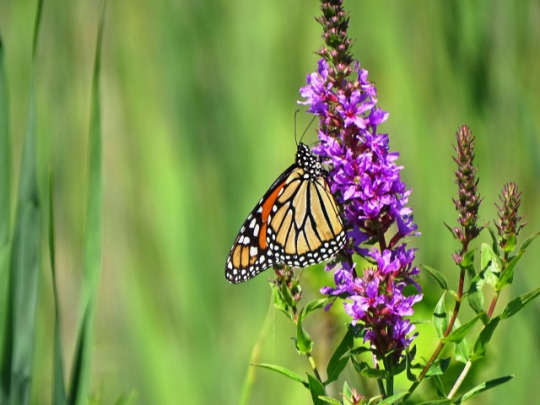
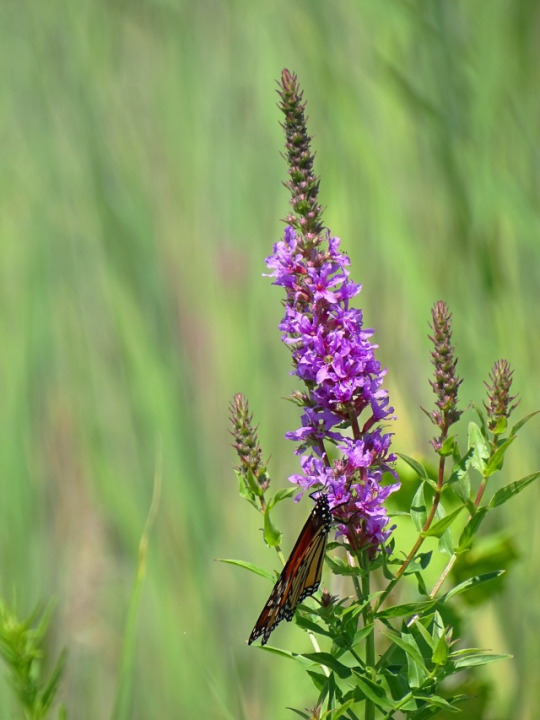


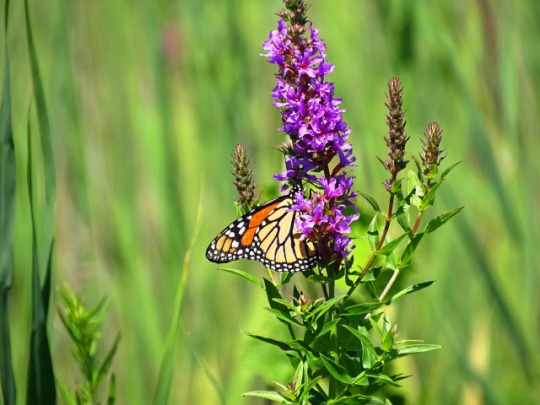
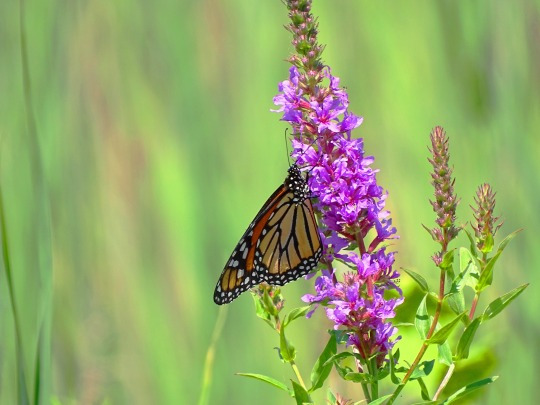
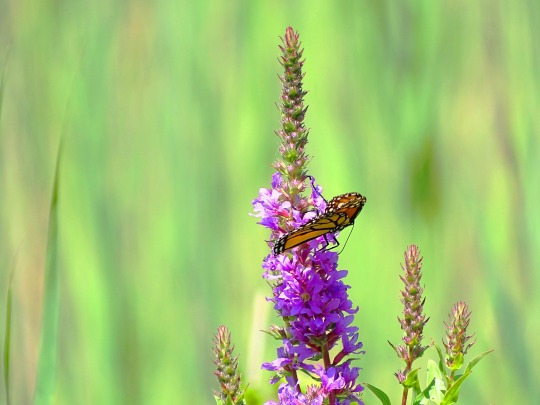
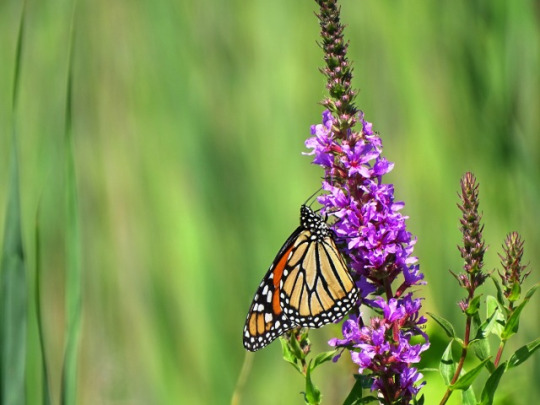


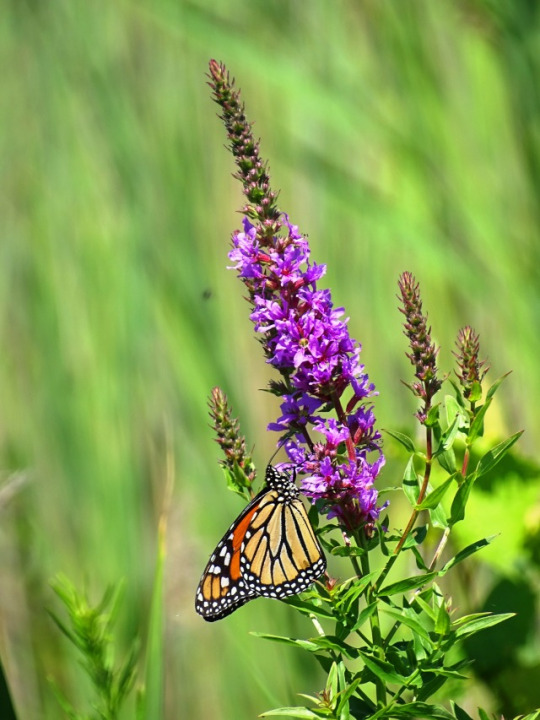
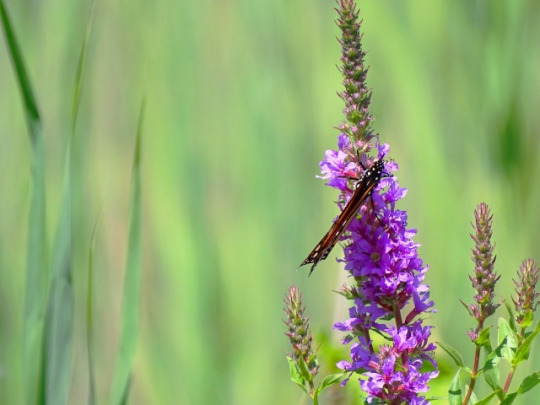

(California) Western Monarch Day
California Western Monarch Day, known informally as Western Monarch Day, was established by the California State Legislature in 2004. The day celebrates the annual migration of the Western monarch butterfly during the winter months—from about October through March—to California's central coast, the only major overwintering spot in the world for the butterflies. The holiday was established with the understanding that it would positively impact tourism and educational programs. Indeed, many visitors come to the area during the migration, boosting tourism at a time of the year when it is otherwise sluggish.
Events are held around the state of California on the day or on a nearby date. In past years, an event has been held at the Mile Square Regional Park in Fountain Valley, California; a "citizen science butterfly count" led by the Irvine Ranch Conservancy has been held at the nearby Limestone Canyon, and the largest celebration in the state has been held at the Pismo Beach State Monarch Butterfly Grove in Pismo Beach. One of the most popular destinations for butterflies in the state, and one of the largest butterfly colonies in North America, Pismo Beach regularly has over 20,000 monarch butterflies clustering in its tall eucalyptus trees.
In addition to Pismo Beach, monarch butterfly groves can also be found in Nipomo, Los Osos, and Morro Bay. In Nipomo, at the Monarch Dunes Butterfly Habitat, up to 60,000 monarchs visit each winter, and make their homes in a grove of blue gum eucalyptus trees. There are two groves in Los Osos: Monarch Grove Natural Area and Sweet Springs Nature Preserve. Monarch Grove Natural Area is made up of 18 acres and is located at the end of Monarch Lane. Sweet Springs Nature Preserve is made up of 24 acres and is located on the Morro Bay estuary. It has been managed by the Morro Coast Audubon Society since 1989. In nearby Morro Bay, Morro Bay Golf Course Monarch Butterfly Grove can be found at the center of Morro Bay Golf Course. Monarchs sometimes come to the grove of eucalyptus trees by as early as August and cluster themselves low on the branches.
As monarchs can't survive cold northern climates, they migrate to warmer climates, sometimes traveling a distance of over 1,000 miles. One of the only insects that migrate, they do so twice a year—like birds do—traveling to a warmer climate and then back again. Western monarchs live west of the Rockies. During the summer months, they can be found in canyons or near rivers in the West, Southwest, and inland in states from California all the way up to British Columbia. A few can be found on the coastal Pacific Northwest as well. Numbering in the tens of thousands, they migrate west and south, mainly nesting in California's central coast. Eastern monarchs, which far outnumber their Western counterparts, live east of the Rockies and migrate south to the high mountains of central Mexico. Monarchs can also be found in Hawaii, Puerto Rico, New Zealand, and on some islands in the Caribbean; those butterflies do not migrate.
Monarchs start as caterpillars. They subsist only on milkweed, a plant that produces glycoside toxins. The caterpillars are immune to the toxins, but predators are not, and are deterred from feasting on the caterpillars because the toxins get stored up in the caterpillars' bodies and make them taste bad. The caterpillars grow and molt for two weeks, form a chrysalis in which they complete metamorphosis, and turn into butterflies. As butterflies, the toxins are still in their systems, still protecting them.
Most adult butterflies only live for a few weeks. During that time, they subsist on nectar from many kinds of plants, search for mates, and look for milkweed on which to lay their eggs. The last generation of monarchs hatch in late summer, and they may live as long as eight months. They don't reach sexual maturity right away and instead make the fall migration. Despite never making the journey before, they know exactly where to go. They remain inactive during the coldest months, but around March, they become sexually mature and then mate. They die soon afterward, and their offspring finish the migration back north.
Between the 1990s and the end of the 2010s, the monarch population declined by about 90 percent, largely on account of habitat fragmentation and loss. Both urban development and intensive agriculture took a toll on habitats. In addition, herbicides killed the milkweed and nectar plants the butterflies feed off of, and insecticides killed the monarchs themselves. Lastly, climate change altered weather patterns and the timing of migration. Because of the drop in monarch numbers, it seems all the more pressing to have a holiday dedicated to them and to the beauty and the mystery of their yearly migration.
How to Observe California Western Monarch Day
Many events are held on or around the date and can be attended if you are able to travel to California. You could check to see if an event is being held at Mile Square Regional Park in Fountain Valley, where in past years butterfly experts have educated and answered questions, and native plants have been available to plant. You could see if the Irvine Ranch Conservancy is hosting a "citizen science butterfly count" at Limestone Canyon. The best place to go for an event is Pismo Beach State Monarch Butterfly Grove in Pismo Beach (the event may be held on a nearby Saturday). At this event, there are butterfly talks and educational booths for adults, and art activities for children. The biggest part of it, of course, are the thousands of monarchs that can be seen hanging in clusters from eucalyptus and pine trees. The grove usually opens in October and stays open throughout the month of February, and docents can be found giving daily talks. You could also visit other butterfly groves today, such as the Monarch Dunes Butterfly Grove in Nipomo, the Monarch Grove Natural Area or Sweet Springs Nature Preserve in Los Osos, or the butterfly grove in the Morro Bay Golf Course. If you can't travel to California, there are still ways you can celebrate. You could take part in the National Wildlife Federation's Garden for Wildlife program, and plant a habitat garden with milkweed and nectar plants for returning monarchs to enjoy. Planting locally native species of plants is the best. Look over some regional guides so you know what to plant in the area you live. You could take part in Butterfly Heroes, another program of the National Wildlife Federation, which is designed to help kids and families raise awareness about declining populations, and to help them to get involved in helping monarchs and other butterflies. The National Wildlife Federation is working to save and restore monarch habitats, and more could be learned about it. You could also learn about the number of Western monarchs in California with Western Monarch Count, encourage your mayor to take the Mayors' Monarch Pledge, or could watch a documentary about monarch migration.
Source
#Western Monarch Day#WesternMonarchDay#California Western Monarch Day#CaliforniaWesternMonarchDay#5 February#butterfly#insect#wildlife#animal#original photography#flora#fauna#Indiana#Midwestern USA#Great Lakes Region#Wolf Lake Memorial Park#Verbena stricta#purple loosestrife#tourist attraction#landmark#countryside#wildflower#blooming#grass#nature#vacation#travel#summer 2019#USA#Hammond
2 notes
·
View notes
Text

Hi MLB fandom, I am a passerby that tried to watch the show for my GF and failed, but I have read a bunch of fanfics and I think Butterfly Emilia would be cool as fuck
Some headcanons:
The butterfly does long-range magic by connecting to others and giving them magic, they're weapon isn't a weapon. It's a tool for communicating with their champions. Emilia has this big ass old timey microphone bc she's a former performer (actress if i rember correctly?) And she's all for the dramatics (Gabriel would have a head set) Despite it not being a weapon, she still wacks people with it
She has seven different pieces of butterfly jewelry on her transform (2 earrings, 2 rings, brooch, hair piece, and one holding her skirt in the back) fighting her directly is very annoying because they have no idea which fucking one is her miraculous
You may notice she's not wearing a mask, just makeup. Her face has been run through every database known to man. The cloaking magic makes it impossible to actually figure out. She doesn't really see herself as a villain, and she doesn't read comic books. Her outfit is more of a performance outfit (Marinette likes western comic books and is super hero themed, Adiren sees himself as a magical girl)
Her main motivation is that she's a MASSIVE control freak with entitlement issues. She was born rich rich and stumbled upon God jewelry. She is drunk on power 24/7 and doesn't think consequences exist. She wants to revive Gabriel bc she loves him. She's terrorizing Paris bc she thinks her happy ending is the most important and doesn't care about anyone else
Gabriel "died" from using both the peacock and butterfly to make Adiren (who Emilia designed herself, with blueprints) despite the fact that Noorou and Duusuo told them that using two miraculouses at once was a bad idea. He's her SIMP
Natalie is her childhood friend who is used to her "eccentric" behavior, and isn't in on the evil
Monarch constantly hyjacks tv/radio waves to harass the heroes. "This would be all be over if you just gave me your miraculous", "Why do you have to drag out this conflict? I just want to fix the wrong thing this magic caused.", "did that old man tell you anything before he gave you those?" <- at first. She tries to have good pr by making all her akumas only capture and sometimes helping people, but eventually she shows her true colors and she's no longer able to make the media call Ladybug and Chat selfish for not giving her their miraculouses. After her flip switches, she still does this, but it's more obvious. "This is all your fault, you know."Maybe I'll just keep doing this at 3am :D." kinda shit
Let's Adiren go to school bc both of the Kawami were like, "He doesn't actually love you. You just made him love you. You're actually a shitty mom." And it hurt her pride so much that she let her control of him slip to prove that he prefers her, and then he wanted to public school and it made her so maddd that she constantly targets the school to scare him and chase him back into her arms "of his own free will"
Emilia thinks Marinette is absolutely perfect and fits in her family so nicely. Except for some minor defects, she can correct ♡ much to Mari's slow dawning horror
Very vindictive and petty. Like, have a butterfly follow Ayla around for a week for reporting on her petty. She is doing psychological warfare on the children
Let's Chloé be childhood friends with Adrien literally bc she makes him uncomfortable, seee how good your mom is compared to others + Really likes Audrey and having perks from the mayor which means they have to be childhood friends
#miraculous ladybug#miraculous fanart#miraculous au#miraculous lb#mlb#mlb fanart#mlb au#art#drawing#artists on tumblr#artist#digital art#digital drawing#artists
22 notes
·
View notes
Text
I have so much to say about the proposed decision to list the monarch butterfly under the Endangered Species Act. There's the raw data which suggests that both the Eastern and Western populations of monarch are well over 50% likely to go extinct within a century if nothing changes. There's the fact that the proposal is fairly novel, legally interesting, and a perfect example of why the ESA is a deeply flawed wildlife protection statute that so clearly is not designed for insects its insane. But mostly, there's the fact that the U.S. agricultural industry is having a meltdown tantrum about it that would make even the most fussy toddler tell them to calm down and take it easy.
There is absolutely no question that the agricultural industry one of the primary reasons why the monarch butterfly is this close to extinction. The combination of habitat loss and pesticide exposure is undeniable. And yet, for the most part, the proposed listing decision goes out of its way to make sure that ag would be largely unaffected. Routine agricultural activities that result in harm to a monarch butterfly would not violate the ESA. If a farmer chooses to remove milkweed or otherwise destroy monarch habitat, that would not violate the ESA. The details about pesticide use haven't been completely hammered out yet, but I have no doubt the impacts to farmers will be minimal at best. All these carve outs, and yet these people are still running around like the sky is falling. Heck, I have an essay-length email sitting at the top of my inbox this morning from a woman who works in the ag-industry in California that is essentially a series of "well what about this" trying to poke holes in Fish and Wildlife's findings (thankfully it is well beyond my job description to answer her in any meaningful way). It's wild.
And what really gets my goat, is that American farmers bill themselves to the public as "stewards of the land." They say this constantly. "We're stewards of the land, we know what we're doing." "Don't regulate us, we're the ones who know how to steward the land." "Of course we care about the environment, we're the ones who steward it." And its such bullshit. Even setting aside the fact that American agriculture is a corner stone of colonialism and is still used as a tool to sit on large swaths of stolen land, American farmers, by and large, simply do not know shit about how the ecosystems they're in function. Last week, I was in a room of people who work in the soybeans industry in the Midwest. Most of the people in that room were farmers or had worked on farms, and I guarantee you that if you asked them, they'd give you the same song and dance about being stewards of the land. That didn't stop one man describing the monarch butterfly as "the most conveniently beautiful pest" there is, and it didn't stop the room from laughing when he said it.
These people don't even understand the vitally important role that pollinators play in our ecosystem. They walk around proclaiming themselves as the One True Steward of the Land, demanding that we thank them for their service, and don't get in the way of them doing what they know is best. But the land is dead to them. A lifeless thing to be mined for profit. A monarch butterfly is a pest to them, and its beauty is inconvenient because it catches the attention of the public.
In her latest book The Serviceberry, Robin Wall Kimmerer talks about how endless growth is never actually endless, and what comes after is always slower and more gentle. It has to be, after all, because what else is left after rapid-fire growth but a slow contraction. I hope she's right, and I hope that the time of extracting as much profit from the land as possible as quickly as possible will soon come to an end. For the sake of the monarch butterfly, for the sake of our more than human relatives, and for the sake of our souls.
#woolly rambles#ngl the hardest part of my job - and the part that i know will ultimately be unsustainable - is having to keep a straight face when ag folk#say the most out of pocket shit imaginable#when i tell you that i wanted to lunge across the table and beat the snot out of that man
8 notes
·
View notes
Text
No Butterflies at the Butterfly Grove: 'the western monarch population has plummeted by 95 percent since the 1980s'
https://www.independent.com/2024/12/06/no-butterflies-at-the-butterfly-grove/
#butterfly#extinction#monarch butterfly#environmental#environment#animalrights#class war#ecology#santa barbara#ausgov#politas#auspol#tasgov#taspol#australia#fuck neoliberals#neoliberal capitalism#anthony albanese#albanese government
6 notes
·
View notes